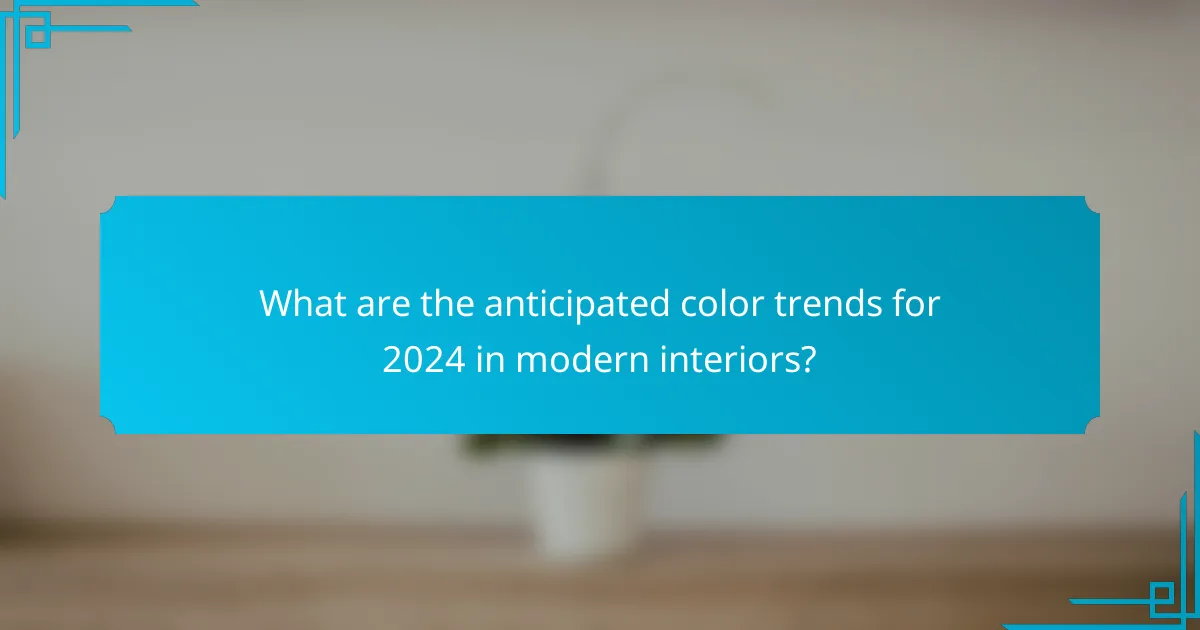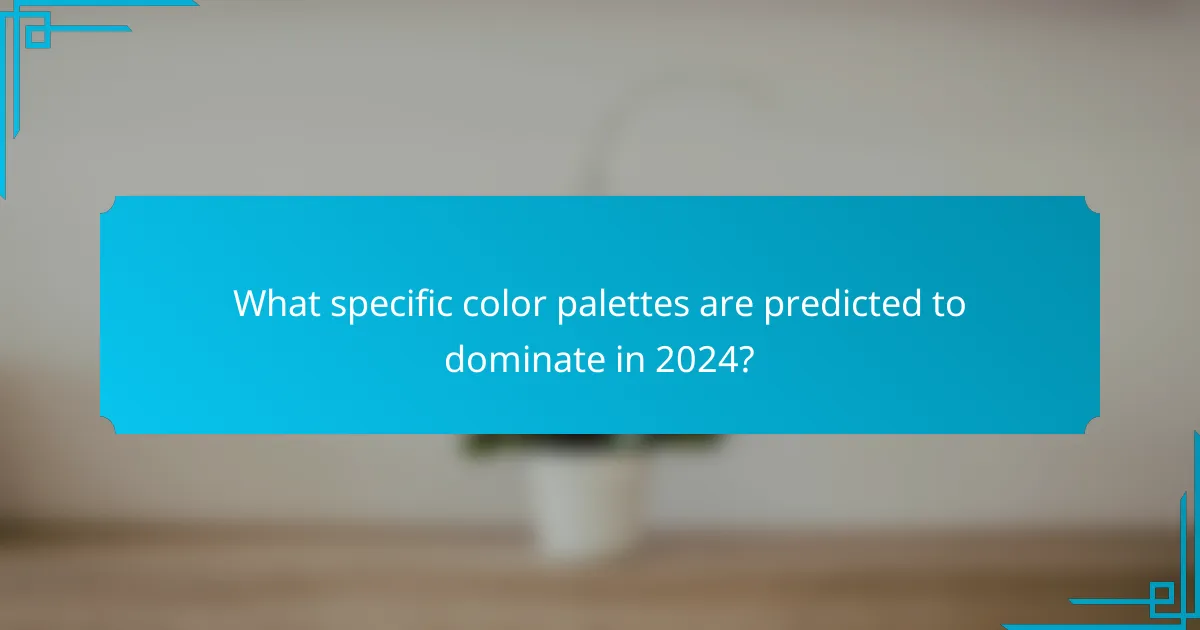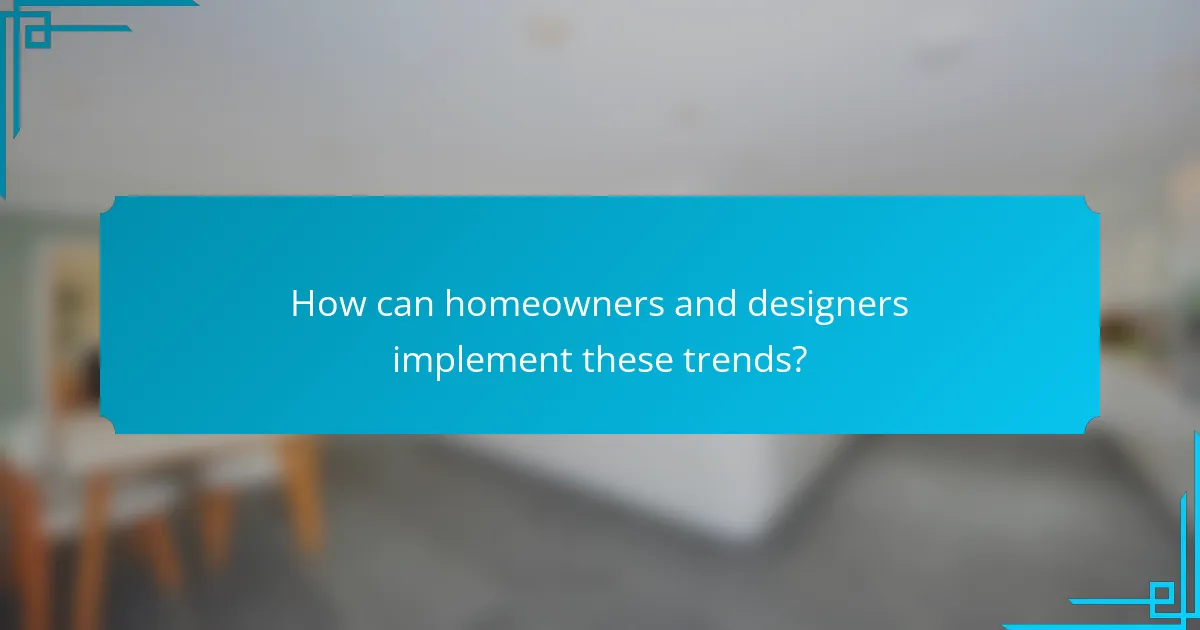Color trends for 2024 in modern interiors highlight a blend of earthy tones, vibrant accents, and soft pastels. Key colors expected to gain prominence include terracotta, sage green, deep blues, and blush pink, reflecting a desire for comfort, warmth, and a connection to nature. The Pantone Color Institute identifies specific shades like “Apricot Crush” and “Verdant Green” as significant for the year. These color palettes aim to enhance well-being and creativity in living spaces, aligning with biophilic design principles. Homeowners and designers can implement these trends by thoughtfully selecting colors for walls, furniture, and decor, utilizing color forecasting tools for informed choices.

What are the anticipated color trends for 2024 in modern interiors?
Anticipated color trends for 2024 in modern interiors include earthy tones, vibrant accents, and soft pastels. Earthy tones like terracotta and sage green promote a sense of calm and connection to nature. Vibrant accents such as deep blues and rich reds add energy and personality to spaces. Soft pastels, including blush pink and light lavender, create a soothing atmosphere. These trends reflect a growing preference for comfort and warmth in home design. According to the Pantone Color Institute, colors like “Apricot Crush” and “Verdant Green” will be prominent in 2024. These selections aim to enhance well-being and foster creativity in interior spaces.
How do these color trends reflect current societal influences?
Color trends reflect current societal influences by showcasing collective emotions and values. For instance, the rise of earthy tones indicates a growing concern for environmental sustainability. These colors resonate with the desire for connection to nature amid urbanization. Additionally, vibrant hues often symbolize optimism and resilience during challenging times. The popularity of these shades can be linked to social movements advocating for change. Furthermore, color palettes in design are influenced by cultural shifts, such as increased diversity and inclusivity. This is evident in the blending of styles and colors from various backgrounds. Overall, color trends serve as a visual representation of societal moods and priorities.
What cultural movements are shaping these color choices?
Cultural movements shaping color choices include minimalism, sustainability, and digital aesthetics. Minimalism emphasizes simplicity and neutral tones. This movement influences designers to choose soft, muted colors. Sustainability drives the use of earthy and organic hues. Consumers increasingly prefer colors that reflect eco-friendliness. Digital aesthetics arise from technology and social media trends. Bright, bold colors often represent virtual experiences. Each of these movements impacts color palettes in modern interior design.
How do sustainability concerns impact color selections?
Sustainability concerns significantly influence color selections in design. Designers increasingly opt for colors that reflect eco-friendly values. Earthy tones, such as greens and browns, symbolize a connection to nature. These colors promote a sense of calm and well-being. Additionally, the use of non-toxic, sustainable dyes affects color choices. Brands are focusing on transparency about their materials and processes. This shift encourages consumers to favor brands that align with their values. Research shows that 66% of global consumers are willing to pay more for sustainable products. Thus, sustainability directly shapes color trends in modern interiors.
What psychological effects do these colors have on interior spaces?
Colors in interior spaces have significant psychological effects. Warm colors like red and orange can stimulate energy and excitement. They often create a sense of warmth and can increase appetite. Cool colors such as blue and green tend to promote calmness and relaxation. These colors can lower stress levels and enhance focus in work environments. Neutral colors like beige and gray provide balance and can create a feeling of sophistication. They often serve as a backdrop for other colors, allowing for versatility in design. Bright colors can evoke feelings of joy and creativity. They can energize a space and inspire innovation. Understanding these effects can guide design choices for desired atmospheres.
How do warm colors influence mood and atmosphere?
Warm colors, such as red, orange, and yellow, significantly influence mood and atmosphere. These colors evoke feelings of warmth and comfort. They can stimulate energy and creativity. Warm colors often create an inviting and cozy environment. Research indicates that red can increase heart rates and stimulate appetite. Yellow is associated with happiness and optimism. Orange can enhance social interaction and enthusiasm. Overall, warm colors play a crucial role in shaping emotional responses and spatial perceptions.
What calming effects do cool colors bring to a room?
Cool colors, such as blue, green, and lavender, bring calming effects to a room. These colors create a serene atmosphere that promotes relaxation. Studies indicate that blue can lower heart rates and reduce anxiety. Green is associated with nature, enhancing feelings of tranquility. Lavender has soothing properties that can contribute to a peaceful environment. The use of cool colors can also improve focus and concentration. In interior design, these hues help create spaces that feel open and airy. Overall, cool colors are effective in fostering a calm and inviting ambiance.

What specific color palettes are predicted to dominate in 2024?
Vibrant and earthy color palettes are predicted to dominate in 2024. These include shades like deep greens, warm terracotta, and rich blues. Additionally, pastel tones such as soft pinks and muted yellows are expected to gain popularity. The trend reflects a desire for connection to nature and tranquility in living spaces. According to color experts, these palettes evoke feelings of comfort and warmth. The use of bold colors alongside softer tones will create dynamic contrasts in interior design. This approach aligns with the growing trend of biophilic design, emphasizing natural elements. Overall, the color palettes for 2024 aim to foster a sense of well-being and harmony in modern interiors.
Which color combinations are expected to be popular?
Soft pastels paired with bold neutrals are expected to be popular. This combination creates a balanced and inviting atmosphere. Shades like blush pink with charcoal gray will be prominent. Earthy tones such as terracotta combined with muted greens are also trending. These combinations reflect a desire for warmth and comfort in interiors. Additionally, vibrant jewel tones mixed with soft whites will gain traction. This contrast adds depth and sophistication to spaces. According to design forecasts, these color pairings align with contemporary aesthetic preferences for 2024.
What are the characteristics of the trending palettes?
Trending palettes for 2024 feature bold, saturated colors and soft, muted tones. These palettes combine vibrant hues with earthy shades for balanced designs. Popular colors include deep blues, rich greens, and warm terracottas. Pastel accents are also prevalent, adding a fresh touch. The use of contrasting colors enhances visual interest. Textures play a vital role, with matte and glossy finishes creating depth. Nature-inspired tones reflect a growing emphasis on sustainability. Overall, these palettes aim to evoke emotion and create inviting spaces.
How can these palettes be effectively incorporated into design?
These palettes can be effectively incorporated into design by aligning them with the intended mood and functionality of a space. Designers should first analyze the emotional impact of the colors. For instance, warm tones can create an inviting atmosphere, while cool colors promote calmness.
Next, palettes can be applied through various elements such as walls, furniture, and accessories. A cohesive color scheme enhances visual harmony. Additionally, contrasting colors can be used strategically to highlight specific areas or features within a room.
Research indicates that color combinations influence perception and behavior. A study by the Institute for Color Research found that people make a subconscious judgment about a person, environment, or product within 90 seconds based on color alone. Thus, careful selection of these palettes can significantly affect the overall design and user experience in modern interiors.
What role do accent colors play in modern interior design?
Accent colors serve to enhance and define spaces in modern interior design. They create focal points that draw the eye and add visual interest. By using contrasting or complementary hues, designers can highlight architectural features or specific areas within a room. Accent colors also contribute to the overall mood and atmosphere of a space. For example, warm tones can evoke coziness, while cool tones can promote calmness. According to a study by the Color Marketing Group, the strategic use of accent colors can significantly influence the perceived size and shape of a room. Thus, accent colors are essential for achieving balance and harmony in modern interiors.
How can accent colors enhance a room’s overall aesthetic?
Accent colors enhance a room’s overall aesthetic by adding visual interest and depth. They create focal points that draw the eye and can energize a space. The strategic use of accent colors can also evoke specific moods or themes. For example, a vibrant yellow can create a cheerful atmosphere. Studies show that color psychology influences emotions and perceptions in interior design. Accent colors can complement or contrast with the main color palette, providing balance. This combination can make a room feel more cohesive and intentional. Additionally, using accent colors can highlight architectural features or artwork. Overall, accent colors play a crucial role in defining a room’s character and style.
What are some examples of effective accent color usage?
Effective accent color usage includes pairing neutral tones with bold hues. For example, a white room can be enhanced with bright yellow cushions. This creates a lively contrast that draws attention. Another instance is using deep blue as an accent in a light gray space. This combination adds depth and sophistication. Additionally, incorporating vibrant green plants against a muted backdrop can energize the environment. These choices highlight the importance of balance in color application. Studies show that strategic accent colors can influence mood and perception.

How can homeowners and designers implement these trends?
Homeowners and designers can implement color trends for 2024 by selecting palettes that reflect current predictions. They should consider using earthy tones and vibrant accents, which are expected to dominate. Incorporating these colors into walls, furniture, and decor can create a cohesive look.
Designers can also utilize color forecasting tools and trend reports to guide their choices. Homeowners can experiment with smaller decor items to test color compatibility before making larger investments.
Research from the Pantone Color Institute indicates that colors significantly influence mood and ambiance. This data supports the idea that thoughtful color selection can enhance interior spaces.
What practical tips can be applied when choosing colors?
Choose a color palette that reflects the mood you want to create. Warm colors like reds and yellows evoke energy. Cool colors such as blues and greens promote calmness. Consider the lighting in your space. Natural light can alter the perception of color. Test paint samples on walls before committing. This allows you to see how colors look at different times of day. Use a color wheel to understand complementary colors. Complementary colors can enhance the overall aesthetic. Limit your palette to three main colors for cohesion. This helps maintain a balanced look throughout the space. Consider the psychology of colors. Different colors can influence emotions and behaviors.
How can one balance bold colors with neutral tones?
To balance bold colors with neutral tones, one should use neutral tones as a backdrop. This creates a foundation that allows bold colors to stand out. For instance, a white or beige wall can enhance vibrant furniture pieces. Additionally, incorporating bold-colored accessories can add interest without overwhelming the space. Using varying shades of neutral tones can create depth while maintaining balance. For example, pairing a navy sofa with light gray pillows can achieve harmony. According to color theory, contrasting colors can complement each other effectively. This approach ensures that bold colors are accentuated rather than clashing with the overall aesthetic.
What tools are available for visualizing color combinations?
Color combination visualization tools include Adobe Color, Coolors, and Paletton. Adobe Color allows users to create color schemes based on various rules. Coolors generates color palettes quickly with a simple interface. Paletton offers interactive color wheel features for custom palettes. These tools help designers select harmonious color combinations effectively. Each tool provides options for exporting palettes for use in design projects.
What common mistakes should be avoided when selecting colors?
Common mistakes to avoid when selecting colors include using too many colors, which can create visual chaos. A limited color palette can enhance harmony and coherence. Ignoring the lighting in a space is another mistake. Colors can appear different under natural and artificial light. Failing to consider the room’s purpose can lead to inappropriate color choices. For instance, calming colors are suitable for bedrooms, while vibrant colors may energize a workspace. Not testing colors before applying them is also a frequent error. Viewing paint samples in the actual space helps ensure the right choice. Lastly, neglecting color psychology can impact mood and perception. Understanding how colors affect emotions can guide better decisions.
How can overuse of trends lead to a dated look?
Overuse of trends can lead to a dated look by creating a sense of uniformity and predictability. When many people adopt the same trends, they lose their uniqueness. This widespread adoption can make once-popular styles feel stale over time. Trends often have a short lifespan, and excessive reliance on them can quickly make a space appear outdated. For example, a color palette that was trendy last year may not resonate in the current year. Additionally, constantly changing trends can lead to a lack of personal expression in design. As tastes evolve, what was once fashionable may become irrelevant. Hence, balancing trends with timeless elements is crucial for longevity in interior design.
What are the pitfalls of ignoring lighting effects on color?
Ignoring lighting effects on color can lead to inaccurate perceptions of color. Different lighting conditions, such as natural light versus artificial light, can significantly alter how colors appear. For instance, a color may look vibrant in daylight but appear dull under incandescent lighting. This discrepancy can impact design choices in interiors, resulting in mismatched color schemes.
Studies show that lighting can affect color perception by up to 50%. This means that selecting colors without considering lighting can lead to unsatisfactory outcomes. Additionally, it can cause confusion in branding and marketing, as colors may not convey the intended message in various lighting scenarios. Overall, neglecting lighting effects can compromise aesthetic appeal and functionality in interior design.
How can these color trends inspire personal style in interior design?
Color trends can significantly inspire personal style in interior design. They provide a framework for selecting color palettes that reflect individual preferences. For example, warm tones can create a cozy atmosphere, while cool hues promote calmness. These trends encourage experimentation with bold colors and unique combinations. Incorporating trending colors can enhance the aesthetic appeal of a space. Additionally, they can influence furniture and decor choices, aligning them with current styles. Research indicates that color can affect mood and perception, making it a vital aspect of design. By embracing these trends, individuals can express their personality through their living spaces.
What are some ways to personalize color choices in a space?
To personalize color choices in a space, consider using accent walls. An accent wall can create a focal point and add depth. Incorporating personal artwork can also influence color selection. Art pieces often reflect personal taste and can guide color themes. Additionally, utilizing textiles like cushions and curtains allows for easy color experimentation. These elements can be changed seasonally or as preferences evolve. Paint samples can help visualize how colors interact with light in the space. Testing colors in different lighting conditions ensures a better match. Finally, using color psychology can enhance mood and functionality. Colors like blue promote calmness, while yellow adds energy.
How can one adapt trends to fit their unique aesthetic?
To adapt trends to fit a unique aesthetic, one should first identify personal style preferences. Understanding the core elements of individual taste is essential. Next, select trends that resonate with these preferences. For example, if a trend emphasizes bold colors, choose shades that align with one’s existing palette. Incorporating unique decor items can also personalize a space. Mixing trending elements with vintage or handmade pieces creates a distinctive look. Additionally, consider scale and proportion when applying trends. This ensures that new elements harmonize with current decor. Lastly, stay flexible and open to evolving one’s aesthetic over time. This approach allows for a dynamic and personalized interpretation of trends.
Color trends for 2024 in modern interiors highlight a shift towards earthy tones, vibrant accents, and soft pastels, reflecting a desire for comfort and connection to nature. Key color predictions include shades like “Apricot Crush” and “Verdant Green,” which aim to enhance well-being and creativity. The article explores how societal influences, cultural movements, and sustainability concerns shape these color choices, alongside the psychological effects of colors on mood and atmosphere. Additionally, it provides practical tips for homeowners and designers on implementing these trends effectively while avoiding common mistakes in color selection.